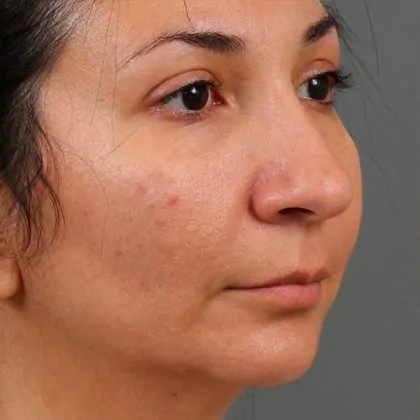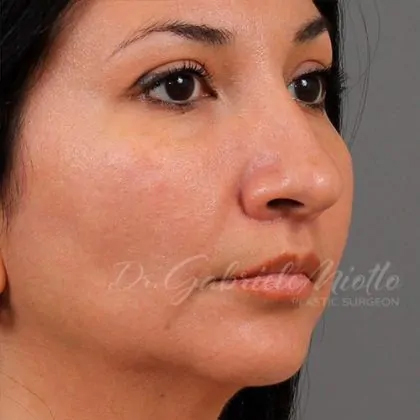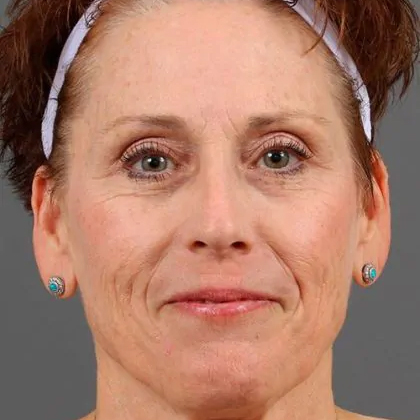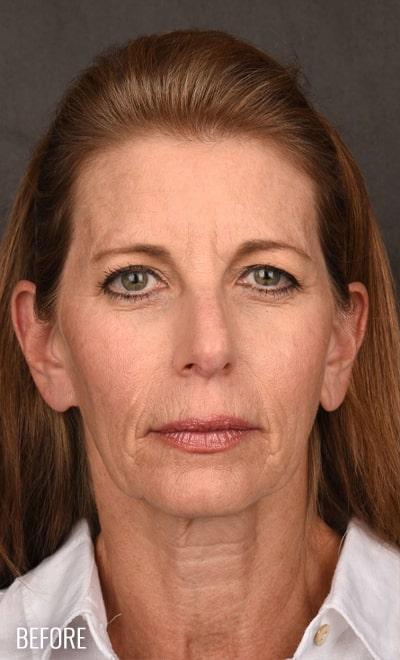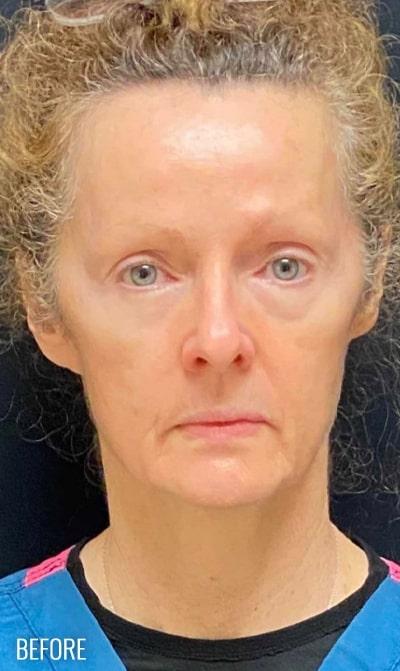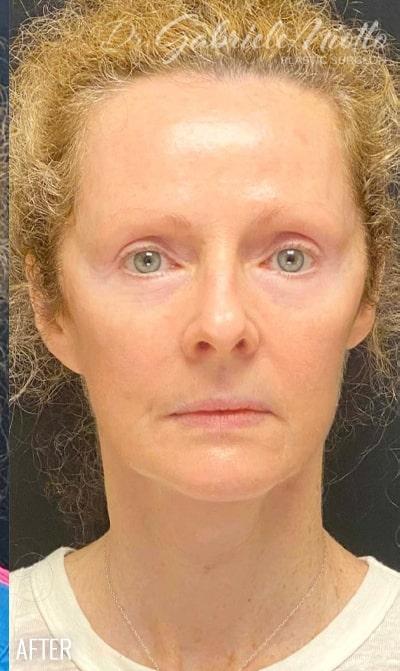Deep Plane Facelift
Conveniently located to serve the areas of Atlanta, GA
Dr. Miotto is recognized as one of the top facial rejuvenation specialists in the country, known for her refined techniques, personalized approach, and natural-looking results. Her dedication to excellence has made her a trusted name in advanced facelift procedures.
Learn more about our signature procedure on the Facelift Atlanta page.

A deep plane facelift, also known as a deep plane rhytidectomy or a deep plane lift, is a plastic surgery procedure that aims to restore a more youthful appearance to the face and neck. A deep-plane facial surgery can provide patients with more natural-looking results than a typical facelift. (1)
With a deep plane lift, Dr Miotto at ME Plastic Surgery in Atlanta can address the signs of aging without causing a tight, overdone, or windblown-looking result. Dr. Gabriele C. Miotto is a plastic surgeon with extensive experience in aesthetic procedures like the deep plane facelift. To learn more about deep plane facelifts, contact ME Plastic Surgery by calling (404) 850-5851 or filling out our contact form.
Contents
Before and After Photos
Patient Story

This is a very fit female patient in her 60s who wanted a refreshed look. She exercises daily and had lost a lot of volume in her face over time. We performed a deep plane face and neck lift to sharpen the jawline and rejuvenate the face and the neck. We also did upper and lower blepharoplasty (eyelid lift) with a lateral brow lift to further open up her look. To improve her facial volume, we added fat grafting to the eyelids and cheeks. She looks refreshed and completely herself after the surgery, with the same smile.
About the Deep Plane Facelift
How do a deep plane lift, a traditional facelift, and the imbrication technique lift differ?
The Traditional Facelift
While performing a traditional facelift, the surgeon focuses mainly on lifting the skin and pulling it taut. Unfortunately, the results of this procedure can provide an overdone or windblown look, which can make the face appear somewhat unnatural. Meanwhile, the deep plane facelift can be more custom-tailored to each patient’s needed lift. (2)
The Imbrication Technique
The imbrication technique involves lifting the skin and tightening the superficial musculoaponeurotic system (SMAS) that lies just beneath. (2) This superficial layer extends from the forehead down to the neck, draping over the muscles of the face. (3) During a superficial musculoaponeurotic system facelift, the surgeon tightens and repositions both the patient’s skin and the SMAS layer beneath. Although the imbrication technique offers a more durable result than the traditional skin-only lift, the more central ligaments underneath the SMAS layer remain untouched or partially released. Because of this, they continue to anchor the sub-SMAS layer, which may not be sufficient to reposition the face and neck effectively for many patients.
The Deep Plane Lift
The deep plane lift releases all the ligaments beneath the SMAS in the lateral and central face, allowing the surgeon to reposition the skin, SMAS, the platysma, and fat pads as a single unit. This repositioning process can improve the longevity of a patient’s results and restore the youthful shape more effectively and reliably.
Benefits
During a deep plane facelift, Dr Miotto will address the cheeks, jowls, and jawline by moving the descended fat and muscles back to their natural positions. (3) By moving these tissues up and back and removing excess skin from the neck and face, the face and jawline appear more youthful. In addition, restoring volume in the upper cheek by this vertical lift helps reduce a hollow appearance and improves drooping beneath the eyes. Since the deep plane facelift requires a high level of skill, it is vital that patients choose a highly experienced plastic surgeon like Dr. Miotto to perform their deep plane facelift.
Candidates
Most patients around the age of 40 start seeing signs of aging around the mouth, eyes, jawline, and neck. Facial fat tissue begins to gradually descend and deflate, impacting the upper and lower cheek areas. As the skin of the neck and face loses its collagen and elasticity, the patients may have a feeling that the face is “melting”. If you are experiencing any of these signs of aging, you might be a great candidate for a deep plane facelift. Candidates often seek out this kind of cosmetic procedure to improve their appearance and increase their self-confidence level. Most deep-plane facelift and neck lift patients are in their late 50s, 60s, and 70s. However, every patient is unique. Some patients desire to address these aging signs earlier, in their mid to late 40s. Instead of putting people into categories, ME Plastic Surgery’s professionals determine a patient’s eligibility during the initial consultation.
We recommend a deep plane facelift for patients who have:
- Muscle laxity in their face and neck
- Deep marionette lines and nasolabial folds
- A sagging jawline
- Wrinkles and loose skin in the neck
- Drooping skin in the mid-to-lower areas of the face
- Jowls and loss of jawline contours
Certain issues may make a patient ineligible for a deep plane facelift at ME Plastic Surgery. These issues include:
- Bleeding disorders
- Clotting disorders
- Psychiatric disorders
- Smoking
- Liver disease
- Uncontrolled diabetes
- A history of radiation treatments to the face or neck (3)
Personal Consultation
During your initial consultation, you will need to provide information about your medical history, including which medications you take regularly, previous surgeries, current health conditions, as well as your herbal supplement and vitamin use. In addition, Dr. Miotto will want to know what you would like to accomplish with a deep plane lift. A sound plan is key to the success of any surgery. After evaluating your neck and facial characteristics, Dr. Miotto can determine if you are a good candidate for a deep plane facelift. If the patient would benefit more from a different procedure, we may recommend something else. To schedule your appointment today, call ME Plastic Surgery in Atlanta at (404) 850-5851 or fill out our contact form.
Preparation
There are several things patients can do in the days leading up to their facelift procedure to prepare. Here are a few things to remember:
- Stop taking aspirin at least 10 days before surgery.
- Do not take non-steroidal anti-inflammatory drugs (NSAIDs) for 7 days before the surgical procedure (Motrin, Aleve, and ibuprofen). Patients who need to take medication for pain during this time frame can take acetaminophen (e.g., Tylenol).
- Stop taking vitamin E at least 10 days before a deep plane facelift.
- Avoid alcohol consumption for at least 7 days before and 7 days after surgery. Alcohol promotes inflammation and bleeding, which can lengthen a patient’s recovery time and cause unnecessary discomfort.
- Stop smoking, vaping, and using chewing tobacco for at least 4 weeks before surgery and 4 weeks after. Nicotine causes blood vessels to contract, which inhibits blood flow. This can negatively affect the body’s ability to heal.
- Stop taking certain herbal supplements at least 10 days before a deep plane facelift. In your preop appointment, we will discuss them all. Following this recommendation is vital because, just like aspirin, these herbs can increase the incidence of bleeding. In addition, herbal supplements can cause an increase in heart rate and elevate blood pressure. Some herbs can also cause a patient to have a negative reaction to anesthesia.
Patients who take prescription medications have to ask Dr. Miotto whether they should discontinue taking them before they have their deep plane lift. If a patient needs to have lab tests done before their facelift procedure, they must complete these tests at least 3 weeks before their surgery. This ensures that Dr. Miotto receives the results in advance. If the surgeon does not receive the lab test results in time, the patient must reschedule their surgery.
Procedure
What to Expect
A deep plane lift usually takes anywhere from 3-5 hours to complete, depending on the patient’s characteristics and goals, previous procedures, and skin quality.
Anesthesia
ME Plastic Surgery’s deep plane facelift patients typically receive general anesthesia, which means they remain fully asleep during their facial enhancement procedure. Following a surgery that involves the patient receiving general or twilight anesthesia, the patient must refrain from driving for at least 24 hours. As such, patients need to bring a driver with them on the day of their surgery. Patients who arrive without a driver will need to reschedule their surgery. Patients will also need a caregiver for at least 24 hours following their surgery. They should choose someone that they fully trust and feel completely comfortable with to serve as their caregiver. We help patients arrange private nursing services if they need help with recovery.
For-Hire Transportation
For the patient’s safety, for-hire transportation is not permissible following any procedure that requires general or twilight anesthesia.
Surgical Area Sanitization
Once the patient is asleep, Dr. Miotto’s team sanitizes the incision areas. Dr. Miotto creates an incision under the sideburn, extending it to the skin around the ear. Placing the incision in this area helps camouflage the scar, thus minimizing future scar appearance. (3)
Anchoring the Tissues
Dr. Miotto lifts the deep plane layer of the face and neck and anchors it up and back to where it used to be. By reattaching the deep plane to this new position, Dr Miotto restores the shape of the cheeks, neck, and jowls. (3)
Removing Excess Skin
After securing the facial tissues, Dr. Miotto places the skin back over the neck and facial structures before trimming away any excess tissue, closing the incisions with no tension and no stretching of the skin.
Closing the Incisions
Dr. Miotto uses very fine sutures to close the external incisions. Some of the sut are absorbable and some will be removed during the first 2 weeks after surgery.
Post-operative Appointment
Our staff at ME Plastic Surgery will schedule all the follow-up visits after surgery. There will be several visits to the office during the first 2 weeks after surgery. Since patients are unable to drive for 24 hours after surgery, they need to have someone drive them to the first in-person appointment and potentially for all follow-ups during the first 2 weeks after surgery.
Recovery

Following surgery, deep plane facelift patients should sleep laying on their backs and elevate their heads with two pillows to improve swelling and proper healing (3) Generally, patients experience peak inflammation and bruising 3-4 days after their deep plane lift. (3) At the 10-day mark, visible improvement in facial and neck shape becomes more evident. After their deep plane facelift, most patients need about 2-3 weeks for the main post-surgical inflammation and bruising to subside. Patients receiving narcotics must refrain from driving until these medications are no longer necessary.
Having a low energy level after surgery is normal and is caused by the body working to heal itself. Therefore, patients need to minimize their activities for a few weeks after their surgery. Light walking and movement at home is okay. Participating in unnecessary or strenuous activities leads to more inflammation, post-op bleeding, and discomfort. (3) The best way to ensure the smoothest recovery possible is to follow Dr. Miotto’s post-surgical recommendations.
Dr. Miotto and her team will remove sutures starting a few days after your surgery and up to 2 weeks after a deep plane facelift and neck lift. About 2 weeks after surgery, most patients plan to return to work or spend time in public. Although there will still be signs of surgery, you can wear makeup. You can apply facial concealer to cover the remaining bruising. While patients can return to most of their normal activities at this time, they must continue to avoid strenuous activities for at least 6 weeks and follow Dr Miotto’s recommendations.
Results
Patients can expect to see their final results about 6 months after surgery. (4) They can expect to have a more youthful-looking neck, a better-contoured jawline, firmer skin, fewer wrinkles, and overall natural and beautifully enhanced facial features.
On average, deep plane facelift results last from 5-10 years, but surgery does not stop the aging process. Each patient is unique, some patients age faster than others, and personal factors will affect how long a patient’s facelift results will last. Some factors affecting the length of facelift results include:
- Skin quality
- Hormonal changes
- Sickness
- Weight fluctuations
- Smoking
- Genetics
- Health status
- Sleep quality
- Sun damage (cumulative) (4)
Although a facelift cannot stop the natural aging process, it does offer patients a way to reset their aging clock. Nonetheless, following a healthy lifestyle and implementing a proven anti-aging skincare routine can help prolong facelift results.
Cost of a Deep Plane Facelift in Atlanta
The cost of a deep plane facelift in Atlanta varies according to the complexity of the surgery, previous facial procedures, and add-on procedures such as the need for fat grafting and eyelid surgery. Therefore, the only way Dr. Miotto can determine how much your procedure will cost is during a consultation. At ME Plastic Surgery we offer in-person and virtual consultations.
Call (404) 850-5851 to request your consultation or fill out our contact form.
Please follow Dr. Miotto on Instagram for daily information about her work @drmiotto. We look forward to helping you in your journey!
FAQ
When will I be event-ready after my deep plane facelift?
We recommend that patients schedule their deep plane facelift at least eight to twelve weeks before an important event. This ensures that visible post-surgical inflammation will subside in time. At the 8-week mark, about 70% of the visible healing is usually complete. However, everyone is unique; it is difficult to predict the details of a patient’s recovery. A patient who would like to be nearly completely healed should have their facelift at least 3 months before their big event.
Does a deep plane facelift hurt?
Since patients remain asleep under anesthesia during their procedures, they are comfortable and feel no pain. After surgery, patients should expect to experience mild discomfort and tightness. This discomfort results from the swelling and bruising that develops following surgery. Some of the other common facelift recovery symptoms include a sore and tight feeling in the face and neck. These post-surgical symptoms can last anywhere from several days to a few weeks. However, to help patients remain as comfortable as possible during recovery, the ME Plastic Surgery team will recommend preoperative and postoperative supplements and medications, as well as provide information about using cold compresses to reduce inflammation, hyperbaric oxygen treatment, lymphatic drainage massage, and red light therapy.
Is any scarring present after a deep plane facelift?
Yes, all surgeries leave scars. Dr. Miotto is an expert in the field of plastic surgery, and take time and care to place the incisions in areas where they will be most hidden. She uses very fine sutures and does not put unnecessary tension on the skin, which optimizes the scars and healing process. As long as patients follow their surgeon’s recommendations, the resulting scars will diminish greatly within 6 months following their facelift procedure. This is the time that these scars usually take to become a lighter color. Dr Miotto and her team follow the healing of the incisions closely. Treatment for scars starts in surgery with the way the tissues are handled, and the way incisions are closed. Further treatments after surgery may include scar gels, creams with sunscreen, microneedling with exosomes, lasers, and chemical peels.
Is there a particular age that is ideal to have a facelift?
There is no ideal time to have a facelift. A patient can decide to seek out a facelift whenever they recognize signs of aging or significant sagging. The age itself is not as important; what is important is what we see on the face. For example, if we start seeing some loose skin or loose muscle and sometimes loss of volume in the face, we can begin to think about the ways we can improve facial aging. Sometimes a facelift is the best, most durable option to align with a patient’s goals. Dr. Miotto pays attention to what the patient desires to achieve and what she can do with surgical or non-surgical procedures.
Should I lose weight before or after my facelift?
When a patient is thinking about having a facelift, they should plan to be at a stable weight by the time of the surgery (within 5 pounds ideally). Weight gain after surgery will increase the volume of the face and neck. Alternatively, if you lose a lot of weight after a facelift, you will likely lose volume in desired areas (cheeks) and lose some skin elasticity. Ideally, the patient should be at a stable weight for at least 3 months before their surgery and plan to maintain this weight after surgery. This will help with the longevity of results.
We will support you in every step of the way.
References
- Jacono AA, Bryant LM, Ahmedli NN. A Novel Extended Deep Plane Facelift Technique for Jawline Rejuvenation and Volumization. Aesthetic Surgery Journal. 2018;39(12):1265-1281. doi:https://doi.org/10.1093/asj/sjy292
- Talei B, Gould D, Hedyeh Ziai. Vectorial Analysis of Deep Plane Face and Neck Lift. Aesthetic Surgery Journal. Published online April 23, 2024. doi:https://doi.org/10.1093/asj/sjae102
- Raggio BS, Patel BC. Deep Plane Facelift. PubMed. Published 2021. https://www.ncbi.nlm.nih.gov/books/NBK545277/
- Yang AJ, Hohman MH. Rhytidectomy. PubMed. Published 2021. https://www.ncbi.nlm.nih.gov/books/NBK564338/


